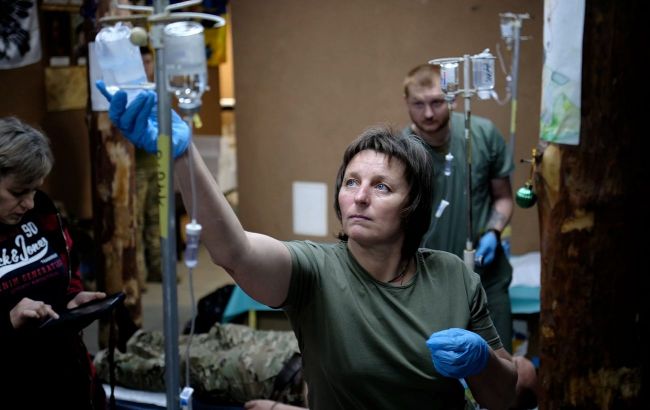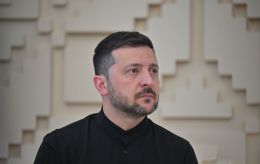We help Russians too, we are not animals: Inside Ukraine's frontline stabilization point near Kramatorsk
 Workers at a stabilization point near Kramatorsk (photo: RBC-Ukraine)
Workers at a stabilization point near Kramatorsk (photo: RBC-Ukraine)
While fighting continues on the frontline, in the rear, there is a different kind of defense line - one where lives are saved every day. Near Kramatorsk, the stabilization point of the 5th Separate Kyiv Assault Brigade is operating. This is where military medics are the first to meet the wounded coming from the hottest parts of the front. More in the report by RBC-Ukraine.
Just a few kilometers from the frontline, and a different battle begins. The stabilization point of the 5th Separate Kyiv Assault Brigade is where every day the question is decided: whose heart will keep beating. Basements have been transformed into full-fledged medical zones. Everything here works toward one goal - to save lives.
Inside the building, it's extremely quiet and calm for now. Morning is sometimes the calmest part of the day for the medics, when the inflow of wounded has slowed. For now, the medical staff can catch a brief moment of rest.
Among the military medics is a male nurse, Ivan. A red-haired man with a kind smile. He graciously gave up his rest to speak with us and share what it's like working at the stabilization point in the Donetsk region.
'We don't have the concept of 'not our brigade''
At the stabilization point, it doesn't matter which unit a wounded soldier comes from. Everyone is accepted - any unit, any direction. There's no such thing here as "ours" or "theirs."
"The situation with the wounded is a bit difficult. Sometimes there are just too many. We simply don't count or track it - we just provide help. But there are a lot of them, really a lot. The frontline is quite wide, so they bring them in from wherever they can. We accept absolutely everyone - there's no distinction whether the brigade is ours or not. We take the whole direction, completely," Ivan explains.
The usage of drones on the frontline creates new challenges not only in combat, but also for medicine - most of the injuries now come from drone strikes.
"These days, many come in with burns. FPV drones carry incendiary shells. That's the most common type of injury right now," says the medical worker.
Transporting a wounded soldier to a stabilization point often requires dangerous maneuvers. Enemy shelling can make evacuation impossible. And the soldiers have to wait.
 Every day, soldiers with injuries of varying severity are taken to the stabilization point (photo: RBC-Ukraine)
Every day, soldiers with injuries of varying severity are taken to the stabilization point (photo: RBC-Ukraine)
"It can be 40–50 minutes, an hour, or even a few days. It depends on where the fighter was wounded and how the evacuation team can get there to retrieve him," says Ivan.
The wounded are never left behind. While logistics are being worked out, necessary medical supplies are delivered by drones.
"If the threat is too high, we drop tourniquets and painkillers from drones. And their comrades provide the assistance," the man adds.
Medics are constantly in contact with the fighters because the initial aid provided often needs to be adjusted to prevent complications such as tourniquet syndrome.
"The type of injury often matters. If there's an amputation and massive bleeding, they can't convert the tourniquet. But sometimes the wound is minor, yet a tourniquet is applied. In such cases, we notify them that they should apply a bandage, remove or loosen the tourniquet," the medic explains.
 Male nurse Ivan worked in intensive care in civilian life (photo: RBC-Ukraine)
Male nurse Ivan worked in intensive care in civilian life (photo: RBC-Ukraine)
'Blood loss is the worst enemy'
Soldiers arrive daily at the stabilization point with various types of injuries, but the most severe cases are those involving massive bleeding. That’s the greatest threat to a fighter's life.
"When a tourniquet is applied too late or incorrectly, we're dealing with massive blood loss. And now it's hot, too. The wounds become inflamed, attracting flies and dirt - we have to clean all of that. Because the fighter still needs to make it to the hospital, where the environment is more sterile," says Ivan.
They often have to remove tourniquets, dress wounds, administer blood and plasma. The medics stabilize and prepare the soldiers for transport.
"We can restore blood flow, administer plasma, run some basic tests, do X-rays, apply splints, and remove tourniquets. We really have a wide range of care. We can take a soldier and send him to the hospital in a more or less stable condition. We also perform resuscitation, intubation, and drainage here when needed," the medic lists.
In wartime, blood is one of the most critical resources for every medical facility. It's what saves lives.
"We use only one blood type - O negative. Right now, we have enough. We place an order, and the hospital provides it. If we run short, we send an emergency vehicle midweek and they deliver the blood to us," Ivan explains.
 It is critically important to transport the injured person quickly, because blood loss is very dangerous (photo: RBC-Ukraine)
It is critically important to transport the injured person quickly, because blood loss is very dangerous (photo: RBC-Ukraine)
Life on edge
Almost "sterile" silence is broken by a loud shout. "Wounded!"
At that moment, every medic jumps into action, ready to receive the soldier. Everyone knows their role and place - and follows the protocol exactly.
A wounded soldier is brought in. A 23-year-old man. His consciousness is foggy; through the bandages around his neck, blood stains are visible. While the doctors do their job, we stand aside and watch, careful not to get in the way - every minute, every movement, counts. Later, Ivan tells us about the wounded man.
"The wound was quite deep. It was a shrapnel injury to the neck and forehead. We stopped the bleeding, stabilized him, and replenished the blood loss. Gave him blood products and plasma. Intubated him, basically, while he was unconscious, and sent him to the hospital," the male nurse explains.
Now the soldier will undergo further treatment at the hospital. The main thing is that he's alive and in stable condition. Later, he'll be in the hands of specialists and rehabilitators.
"It's a serious injury, since it's the neck and head. The outcome in such cases is hard to predict. That's now in the hands of neurosurgeons," Ivan explains.
 Doctors often remove tourniquets, apply dressings, and inject blood and plasma (photo: RBC-Ukraine)
Doctors often remove tourniquets, apply dressings, and inject blood and plasma (photo: RBC-Ukraine)
Each time medics send a wounded soldier to the next stage of care, they truly hope he will recover quickly. Ivan recalls one of the hardest cases he's encountered during his service.
"There was a case where a soldier was brought in in extremely serious condition - with both legs amputated, one arm gone, and wounds to the abdominal and chest areas. And just as they were arriving at the stabilization point, his heart stopped. We brought him back, successfully resuscitated him. From what we later heard, he made it to Dnipro. What happened after that - we don't know," the male nurse recalls.
You never get used to it, but you have to work
The hardest part for any medic is to suppress and shut off their emotions, because emotions can interfere with providing quality care. Some medics are only learning this skill here; others came with it, already hardened by prior medical experience.
"When I joined the military, I already had that barrier - I'd worked for many years in a hospital, in the intensive care. If I get too emotionally attached to one person, I won't be able to properly help the next one. My goal is to provide as much care to as many fighters as possible, and just draw a curtain, detach myself, and keep working. I know that if I get distracted here, I could miss something there, and we don't have the right to do that. For us, every soldier's life is like our own," Ivan explains.
What if the wounded is enemy
Ukrainian medics often have to treat captured Russian soldiers, brought in by the troops from the front line. But even knowing it's the enemy, they provide full care, just like they would for their own.
"You see the wound, you treat the wound. You provide care, and that's it. We're not animals. We can't finish off someone like ourselves," Ivan emphasizes.

